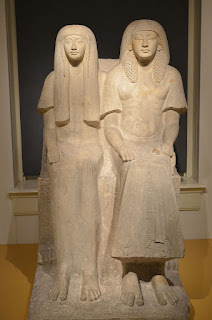Hemira, conocida por sus amigos con el apodo de Hemi, fue una sacerdotisa de la diosa Hathor que vivió durante el Primer período intermedio.
De
esta mujer conocemos muy pocas cosas, por algunos textos jeroglíficos
que aparecen en la falsa puerta, procedente de su tumba en Busiris
sabemos algunos detalles de la vida de esta mujer, los cuales iremos
desvelando.
En la falsa puerta aparecen algunos datos, pero como comenté
anteriormente no muchos, y la mayoria de ellos se refieren a los
suministros de provisiones para el templo de Hathor, por eso poco se
sabe de ella aunque por las caracteristicas de esa puerta falsa podemos
apreciar algunas cosas.
También comenté que fue una sacerdotisa de
la diosa Hathor, es decir, una diosa menor en la zona. Busiris era la
capital del IX nomo, en el Delta central y Per Usir significa
lugar donde vive o reside Osiris. Al ser esta zona muy importante para
las peregrinaciones de numerosos egipcios, era pues una zona en la que
el culto importante estaba dirigido a este dios y los cultos a otros
dioses era de menor importancia. Y aquí aparece esta mujer como
sacerdotisa de Hathor.
las tres figuras las de Hemira, y que representan toda su vida porque la
anciana es la última pero la anterior es la figura de la Hemira
"madura", al menos yo lo veo así, aunque cuando tengamos todos los relieves de la puerta falsa sabremos más.
Además
tampoco puede ser una hija o familiar de Hemira (la chiquilla sentada)
porque parece que no se citan ni esposo ni a nadie de la familia.
Casi siempre se habla de los poderosos, de reyes y reinas, nobles , etc por eso hablar un poco de Hemira, es decir, de alguien no importante y que simplemente fue una humilde sacerdotisa que vivió toda una vida dedicada a su función sacerdotal…. y por eso me gustaría poder colgar la foto completa de la falsa puerta, que por cierto hay una inscripción (citada por Wilkinson) , en la que ella pide a todas las personas que pudieran hacer una visita a su tumba : “Por lo que respecta a toda esa gente que diga: pan para Hemi en su tumba, yo soy un espíritu poderoso y los preservaré de todo mal”.
fuente foto:
https://www.meisterdrucke.uk/.../False-door-from-the-tomb...





































